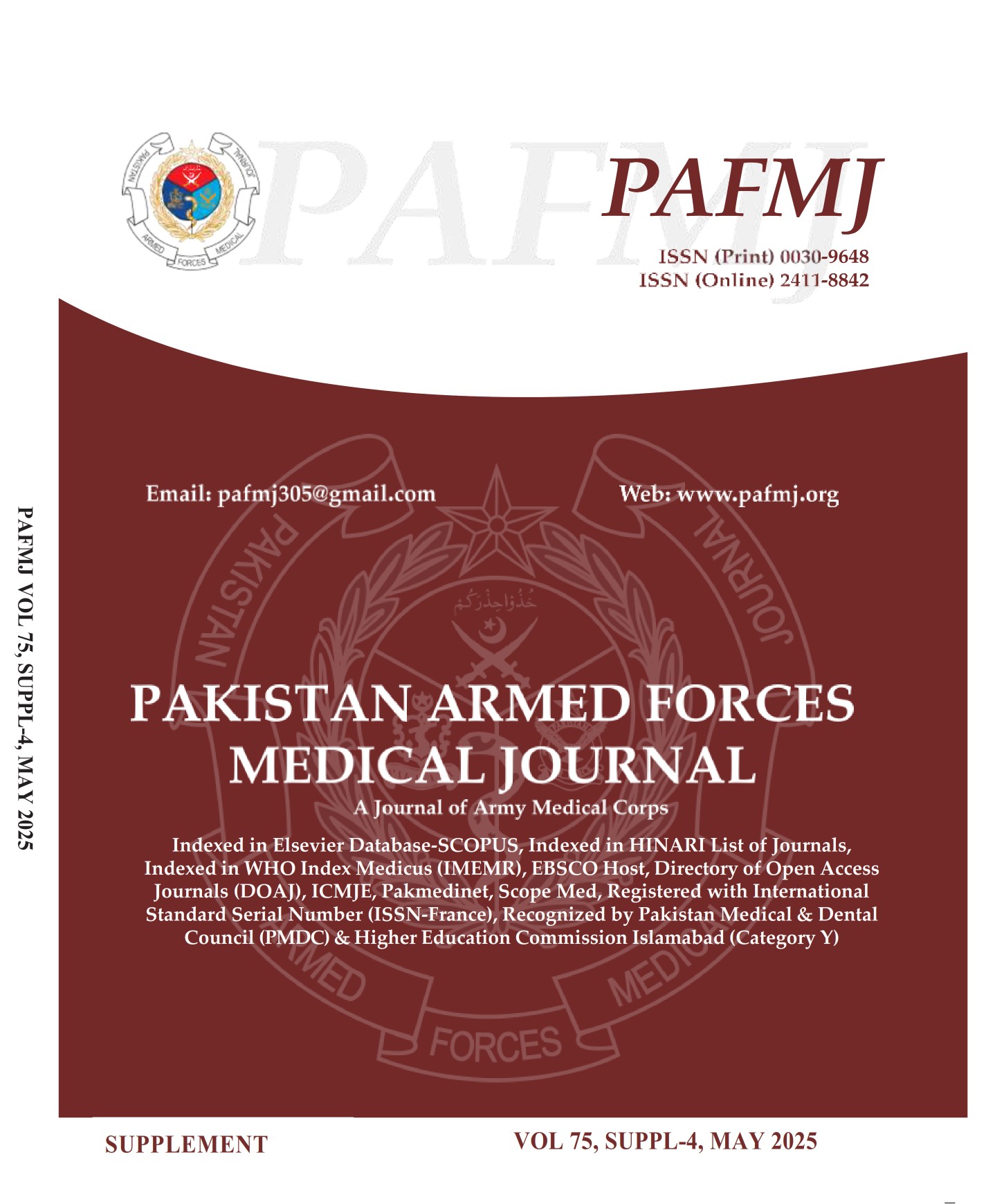Diagnostic Value of Hyperbilirubinemia as a Predictor for Appendiceal Perforation in Acute Appendicitis
DOI:
https://doi.org/10.51253/pafmj.v75iSUPPL-4.10166Keywords:
Appendicitis, Appendectomy, Bilirubin, Diagnostic Accuracy, Perforation.Abstract
Objectives: To determine the diagnostic accuracy of hyperbilirubinemia as a predictor for “appendiceal perforation” in acute appendicitis.
Study Design: validation study.
Place and Duration of Study: Department of General Surgery, Combined Military Hospital, Rawalpindi Pakistan, from Sep to Feb 2022.
Methodology: A total of 96 patients having acute appendicitis were included Serum bilirubin levels were documented. Patients then underwent appendectomy and based on operative finding diagnosis of simple/perforated appendicitis was made. 2x2 table was drawn for sensitivity, specificity, PPV and NPV.
Results: In our study, mean age of study population was 20.86±3.26 years. There 46(47.90%) male participants while remaining 50(52.10%) participants were female. Mean duration of symptoms was 10.79±2.56 hours. Mean serum bilirubin was 1.28±0.74 mg/dl. Sensitivity, specificity, positive predictive value and negative predictive value of “hyperbilirubinemia” as a predictor for “appendiceal perforation” in acute appendicitis was 63.64%, 76.92%, 70.00% and 71.43%, respectively.
Conclusion: Raised serum levels of bilirubin can serve as a potentially useful laboratory test for predicting “appendiceal perforation”.
Downloads
References
Ghorbani A, Forouzesh M, Kazemifar AM. Variation in anatomical position of vermiform appendix among Iranian population: an old issue which has not lost its importance. Anat Res Int 2014; 313575. https://doi.org/10.1155/2014/313575
Kooij IA, Sahami S, Meijer SL, Buskens CJ, Te Velde AA. The immunology of the vermiform appendix: a review of the literature. Clin Exp Immunol 2016; 186(1): 1-9.
https://doi.org/10.1111/cei.12821
Killinger B, Labrie V. The appendix in Parkinson's Disease: From vestigial remnant to vital organ? J Parkinsons Dis 2019; 9(s2): S345-S358. https://doi.org/10.3233/JPD-191703
Stringer MD. Acute appendicitis. J Paediatr Child Health 2017; 53(11): 1071-1076. https://doi.org/10.1111/jpc.13737
Viniol A, Keunecke C, Biroga T, Stadje R, Dornieden K, Bösner S, et al. Studies of the symptom abdominal pain--a systematic review and meta-analysis. Fam Pract 2014; 31(5): 517-529. https://doi.org/10.1093/fampra/cmu036
Gomes CA, Abu-Zidan FM, Sartelli M, Coccolini F, Ansaloni L, Baiocchi GL, et al. Management of Appendicitis Globally Based on Income of Countries (MAGIC) Study. World J Surg 2018; 42(12): 3903-3910. https://doi.org/10.1007/s00268-018-4736-1
Walczak DA, Pawełczak D, Żółtaszek A, Jaguścik R, Fałek W, Czerwińska M, et al. The value of scoring systems for the diagnosis of acute appendicitis. Pol Przegl Chir 2015; 87(2): 65-70. https://doi.org/10.1515/pjs-2015-0021
Rud B, Vejborg TS, Rappeport ED, Reitsma JB, Wille-Jørgensen P. Computed tomography for diagnosis of acute appendicitis in adults. Cochrane Database Syst Rev 2019; 2019(11): CD009977.
https://doi.org/10.1002/14651858.CD009977.pub2
Bickel A, Ganam S, Abu Shakra I, Farkash I, Francis R, Karra N, et al. Delayed diagnosis and subsequently increased severity of acute appendicitis (compatible with clinical-pathologic grounds) during the COVID-19 pandemic: an observational case-control study. BMC Gastroenterol 2022; 22(1): 19.
https://doi.org/10.1186/s12876-021-02024-9
Bakshi S, Mandal N. Evaluation of role of hyperbilirubinemia as a new diagnostic marker of complicated appendicitis. BMC Gastroenterol 2021; 21(1): 42.
https://doi.org/10.1186/s12876-021-01614-x
Balogun OS, Osinowo A, Afolayan M, Olajide T, Lawal A, Adesanya A. Acute perforated appendicitis in adults: Management and complications in Lagos, Nigeria. Ann Afr Med 2019; 18(1): 36-41. https://doi.org/10.4103/aam.aam_11_18
Patel JJ, Taneja A, Niccum D, Kumar G, Jacobs E, Nanchal R. The association of serum bilirubin levels on the outcomes of severe sepsis. J Intensive Care Med 2015; 30(1): 23-29.
https://doi.org/10.1177/0885066613488739
Suleimanov V, Alhanabi FH, Al Saeed FH, Aldrazi HA, Fagir HA. A rare complication of perforated appendicitis: a case of necrotizing fasciitis. Cureus 2022; 14(9): e29679.
https://doi.org/10.7759/cureus.29679
Vineed S, Naik RKH. Diagnostic accuracy of hyperbilirubinemia in predicting perforated appendicitis. Int Surg J 2017; 4(10): 3441-3444. https://doi.org/10.18203/2349-2902.isj20174512
Emmanuel A, Murchan P, Wilson I, Balfe P. The value of hyperbilirubinaemia in the diagnosis of acute appendicitis. Ann R Coll Surg Engl 2011; 93(3): 213-217.
https://doi.org/10.1308/147870811X566402
Hong YR, Chung CW, Kim JW, Kwon CI, Ahn DH, Kwon SW, et al. Hyperbilirubinemia is a significant indicator for the severity of acute appendicitis. J Korean Soc Coloproctol 2012; 28(5): 247-252.
https://doi.org/10.3393/jksc.2012.28.5.247
McGowan DR, Sims HM, Zia K, Uheba M, Shaikh IA. The value of biochemical markers in predicting a perforation in acute appendicitis. ANZ J Surg 2013; 83(1-2): 79-83.
https://doi.org/10.1111/ans.12032
Atahan K, Üreyen O, Aslan E, Deniz M, Çökmez A, Gür S, et al. Preoperative diagnostic role of hyperbilirubinaemia as a marker of appendix perforation. J Int Med Res 2011; 39(2): 609-618.
https://doi.org/10.1177/147323001103900230
Ramasamy Ramu T, Chinnakkulam Kandhasamy S, Andappan A, Sankar T B. A prospective study on the diagnostic value of hyperbilirubinemia as a predictive factor for appendicular perforation in acute appendicitis. Cureus 2018; 10(8): e3214.
https://doi.org/10.7759/cureus.3214
Estrada JJ, Petrosyan M, Barnhart J, Tao M, Sohn H, Towfigh S, et al. Hyperbilirubinemia in appendicitis: a new predictor of perforation. J Gastrointest Surg 2007; 11(6): 714-718.
Downloads
Published
Issue
Section
License
Copyright (c) 2025 Sohaib Ashraf, Muhammad Shoaib Khan, Paras Ibn E Ali, Sajid Ali, Rashid Iqbal Khan, Abdur Rehman Rashid

This work is licensed under a Creative Commons Attribution-NonCommercial 4.0 International License.















